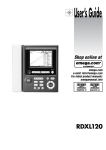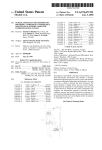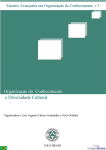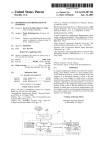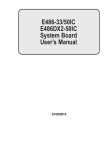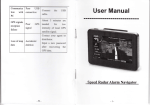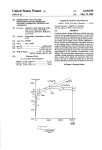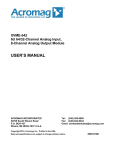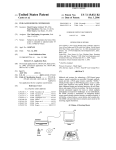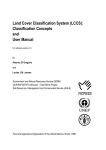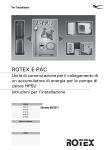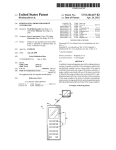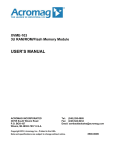Download Method and apparatus for incoming call rejection
Transcript
US006253075B1
(12) United States Patent
(10) Patent N0.:
Beghtol et al.
(54)
(75)
US 6,253,075 B1
(45) Date of Patent:
Jun. 26, 2001
METHOD AND APPARATUS FOR
5,758,280 *
INCOMING CALL REJECTIQN
5,835,582 * 11/1998 Matsuda et a1. ................... .. 379/373
5,930,351 * 7/1999 Lappen et a1.
. 379/373
Inventors: Justin ~ Beghtol; Kenneth Mar; both of
,
San Dlego’ CA(US)
,
i
6,108,630 *
(73)
Assigneez Nokia Mobile Phones Ltd” Espoo (F1)
(*)
Notice:
5/1998 Kimura .............................. .. 455/412
sBlllofll
e1 e ~~~~~~~~~~
......... ..~~
..
8/2000 Kuechler e161. .................. .. 704/270
6,122,347 * 9/2000 Borland ................................ .. 379/70
FOREIGN PATENT DOCUMENTS
Subject to any disclaimer, the term of this
patent is extended or adjusted under 35
4-258029 *
U.S.C. 154(b) by 0 days.
9/1992 (JP) ............................... .. HO4B/7/26
* cited by examiner
Prim/1r Examiner—Daniel Hunter
(21) Appl' NO‘: 09/212’757
Assist/lit Examiner—Pablo Tran
(22) Filed;
(74) Attorney, Agent, or Firm—Brian T. Rivers
Dec_ 16, 1998
Related US. Application Data
(57)
ABSTRACT
(60)
Provisional application No- 60/086,032, ?led on May 19,
1998-
in a mobile communications device. The method and appa
(51)
Int. Cl.7 .................................................... .. H04M 3/42
rams Permit a user of a mobile Communications device to
(52)
US. Cl. ........................ .. 455/415; 455/412; 455/567;
379/142
ehtethetieehy reJ'eet eehs ihtehded te he reeeived hY the
device. In an exemplary embodiment; a rejection memory
(58)
Field of Search .................................. .. 455/404 33.1
Within the mobile device is preprogrammed With identi?ca'
455/541 90 525 550 422 567 455’_458’
412_41’5 565, 579/129 {27 6’7_69 201’
207 21,1 37,3 372 3,74 3,76 350’ 140’
’
’
’
’
’
’ 19é_200’
Amethod and apparatus for rejecting incoming calls for use
tion information representative of transmitting stations to'be
rejected. When a call is mcommg; identi?cation information
included With the incoming call is compared With identi?
cation information contained in the rejection memory. When
a match is detected; a rejection message is automatically sent
(56)
References Cited
by the mobile communications device to the transmitting
U.S. PATENT DOCUMENTS
ting station terminates the call and may reroute the call to a
station. Upon receipt of the rejection message; the transmit
5 329 578 *
7/1994 Brennan 6161. ..................... .. 379/67
Voice messaging System Additionally’ upon display of the
5:553:125
9/1996 Martensson
identi?cation information of an incoming call, the user may
5,559,860
9/1996 Mizikovsky ......................... .. 379/58
manually trigger the transmission of the rejection message
5,657,372
8/1997 Ahlberg e161. .................... .. 455/414
from the mobile Communications device
5,661,788
8/1997
5,748,709 *
5/1998 Sheerin ................................ .. 379/67
Chin ......... ..
379/14O
379/142
15 Claims, 4 Drawing Sheets
200
MOBILE PHONE ON STANDBY
ENTER PHONE NUMBERS TO
BE REJECTED INTO
202
r204
REJECTION MEMORY OF PHONE
INCOMING CALL
IS NUMBER
IN REJECTION
MEMORY?
DOES USER
WANT TO REJ ECT
CALL’?
PHONE SENDS REJECTION
MESSAGE TO BASE
STATION IMMEDIATELY
206
U.S. Patent
Jun. 26, 2001
100
\,
Sheet 1 of4
FIG.
US 6,253,075 B1
7
DISPLAY x110
104
\
RIEJEFACJFIQQN
KEYPAD
fIIZ
CALL
[114
CONTROLLER f1 02
INDICATOR
120
MESSAGE
PROCESSOR
L
TRANSMITTER T
RIC
\6 m
124
122
H
DETERMINER \106
RECEIVER “L
118/
I
123
30g
MESSAGE TYPE
FEATURE DESCRIPTION RECORD TYPE (BINARY)
FLASH WITH INFORMATION MESSACE
FEATURE INDICATOR
00000010
FIG. 3 a
302
x
TYPE SPECIFIC FIELD
FEATURE IDENTIFIERS (BITS)
INCOMING CALL REJECTION
OOOO
RESERVED
XXXX
FIG. 3b
U.S. Patent
Jun. 26, 2001
Sheet 2 of4
US 6,253,075 B1
ENTER PHONE NUMBERS
402\ TO BE REJECTED INTO
REJECTION MEMORY
400\
200
OF PHONE
4
4O4\
MOBILE PHONE
MOBILE PHONE ON STANDBY fZOZ
0N CURRENT CALL
ENTER PHONE NUMBERS TO
406\ INCOMING SECOND CALL
BE REJECTED INTO
I204
REJECTION MEMORY OF PHONE
I
INCOMING CALL
408
f
206
208
YES
IS
NUMBER OF SECOND
‘V
CALL IN REJECTION
NO INDICATION
TO USER ABOUT
HISRBEIBJEJCEIESN
INCOMING CALL
MEMORY?
/
410
PROVIDE USER
INDICATION OF SECOND
210
DOES USER
INCOMING CALL
NO
WANT TO REJECT
DOES USER
CALL HAN DLED
2T 4
WANT TO REJECT
NORMALLY
\
USER INTERACTION
CALL?
N
422
212
\
E
USER INTERACTION
V
PHONE SENDS REJECTION
MESSAGE TO BASE
STATION IMMEDIATELY
I
CALL RELEASED
‘v
\216
412/
STATION IMMEDIATELY
I
\218
I
CALL SENT TO VOICE MAIL \220
PHONE SENDS REJECTION
MESSAGE TO BASE
414/ SECOND CALL RELEASED
I
SECOND CALL SENT
F[G_
2
416/
TO VOICE MAIL
‘___
424/ CALL HANDLED NORMALLY
FI G. 4
U.S. Patent
FIG.
Jun. 26, 2001
Sheet 3 of4
5
US 6,253,075 B1
503
501
N
/
COMMUNICATION
/
CHANNEL
BASE STATION
MOBILE STATION
< PACINQ CHANNEL <
50?
MESSAGE
SENDS PAGE RESPONSE
500
/
502
505
50/7
SENDS PAGE) MESSAGE
504
> ACCESS CHANNEL >
308
SETS UP TRAFFIC CHANNEL
BEGINS SENDING NULL;509
512
511
\
SETS UP TRAFFIC CHANNEL
/
< PAGING CHANNEL <
510
VALID FRAMES \
515
513
> REVERSE TRAFFIC >
CHANNEL\PREAMBLE
CHANNEL
514
< FORWARD TRAFFIC <
513
BEGIN TRANSMITTING
501
SENDS BASE STATION /
ACKNOWLEDGEMENT ORDER
> REVERSE TRAFFIC >
NULL TRAFFIC DATA 523
BEGIN PROCESSING PRIMARY
TRAFFIC IN ACCORDANCE
52rd’ CHANNEL
526
521
< FORWARD TRAFFIC <
CHANNEL \
WITH SERVICE OPTION 1
< FORWARD TRAFFIC <
CHANNEL \
527
IF MATCH, THEN TRANSMIT
REJECTION MESSAGE;
53()
IF NO MATCH, RING /
AND DISPLAY CALLER ID.
525
> REVERSE TRAFFIC >
524
SENDS ALERT WITH /
INFORMATION MESSAGE
(CALLER ID AND RING)
RELEASE CALL\529
/ CHANNEL
528
532
/
IF USER "REJECP’ INPUT
> REVERSE TRAFFIC >
DETECTED TRANSMIT \
REJECTION MESSAGE 531
CHANNEL
IF USER "ANSWER” INPUT
DETECTED TRANSMIT CONNECT
SENDS SERVICE/OPTION
RESPONSE ORDER
522
REJECTION MEMORY;
\
ACQUIRES THE REVERSE
TRAFFIC CHANNEL
51’8" CHANNEL
534
516
/
BEGIN SENDING TRAFFIC
ORDER
SENDS CHANNEL
ASSIGNMENT/ MESSAGE
RECEIVES N CONSECUTIVE
COMPARE ID TO/
TRAFFIC CHANNEL DATA
> REVERSE TRAFFIC >
CHANNEL \
535
RELEASE CALL\533
CONNECT CALL\536
>537
U.S. Patent
Jun. 26, 2001
US 6,253,075 B1
Sheet 4 0f 4
600
603
601
MOBILE STATION/
USER CONVERSATION WITH
COMMUNICATION
CHANNEL
604
6/02
BASE STATION
< FORWARD AND REVERSE USER CONVERSATION WITH
TRAFFIC/ CHANNELS >
FIRST PARTY
'/
606
FIRST PARTY
\
605
DETECTS INCOMING (:ALL/607
609
610
COMPARE /ID TO REJECTION
MEMORY;
608
CHANNEL
SENDS ALERT WITH /
INFORMATION MESSAGE.
> REVERSE TRAFFIC >
RELEASE CALL\615
< FORWARD /TRAFFIC <
(CALLER ID, CALL WAITING TONE)
IF (ID MATCHES)
61 1
THEN; /
TRANSMIT REJECTION MESSAGE
CHANNEL
/
614
ELSE;/
612
GIVE CALL WAITING TONE,
DISPLAY IO INFORMATION
IF (DEFECT USER MANUAL
REJECT INPUT) \
615
617
616
IF YES;/
> REVERSE TRAFFIC >
TRANSMIT REJECTION MESSAGE
RELEASE CALL"\— 61 8
CHANNEL
IF (DETECT USER REQUEST TO
CHANGE PARTIES)\
619
621
IF YES THEN;
TRANSMIT FLASH WITH
> REVERSE /TRAFFIC >
INFORMATION MESSAGE
CHANNEL
620
FIG. 6
622
/
MUTE SPEECH PATH TO FIRST
PARTY, CONNECTS SECOND PARTY.
US 6,253,075 B1
1
2
Typically, When a landline user calls a mobile phone user,
METHOD AND APPARATUS FOR
INCOMING CALL REJECTION
the base station acts as an intermediary by alerting the
mobile of the attempted call via at least one RF channel.
After alerting the mobile, the base station Waits for a ?xed
time period, Which de?nes a ringing cycle, to receive a
response from the mobile. The response indicates the mobile
is ready to accept the call. If the mobile does not respond
CLAIM OF PRIORITY FROM A COPENDING
PROVISIONAL PATENT APPLICATION
Priority is herewith claimed under 35 U.S.C. §119(e) from
copending Provisional Patent Application 60/086,032, ?led
May 19, 1998, entitled “Incoming Call Rejection,” by Justin
Within the ringing cycle time period, the base station releases
the call by terminating the call alert to the mobile and
signaling to the caller that the mobile is unavailable. During
the ringing cycle, the mobile phone produces an audible
Beghtol and Kenneth Mar. The disclosure of this Provisional
Patent Application is incorporated by reference herein in its
entirety.
ringing or mechanical vibration to alert the mobile phone
user of the incoming call. If the mobile phone user decides
to ansWer the incoming call, a response is sent from the
mobile to the base station indicating that the call is to be
accepted. The base station then sets up a connection on the
existing RF channel or establishes a second RF channel
FIELD OF INVENTION
The present invention relates generally to call processing
techniques in cellular telecommunications systems. More
particularly, the present invention relates to apparatus, and
associated method, for rejecting incoming calls to a mobile
communications device Within a cellular telecommunica
tions system.
20
referred to as caller ID. This identi?cation information can
be displayed by the mobile phone alloWing the mobile phone
BACKGROUND OF THE INVENTION
user to determine Who is calling before the call is ansWered.
If the mobile phone user decides not to receive calls from
Wireless telecommunications systems provide a conve
nient Way for users to communicate When landline phones
speci?c callers, the identi?cation information can be vieWed,
and if desired, the incoming call can be left unansWered for
are unavailable. What Was once an expensive luxury is noW
an affordable convenience. By simply carrying a small,
lightWeight mobile communications device, users may place
or receive calls of excellent quality in any geographic region
offering such Wireless service.
Typically, Wirelesstelecommunications systems are made
the entire ringing cycle.
30
up of a series of base stations connected to landline tele
communications netWorks through the use of base station
controllers. The base stations have the capacity to commu
nicate With each other via the base station controllers and to 35
establish a ?xed number of radio frequency (RF) commu
nications channels With remote mobile phones. The RF
mobile phones may ultimately communicate With landline
45
is still processed by the phone until released, Which may
prevent the phone from handling other calls. There may also
be times When a user desires to refuse all communications
from certain callers. Such times may occur When prank
callers or telemarketers repeatedly call or When users simply
adequate background information regarding mobile phone
operation in an IS-95 telecommunications environment. As
55
inphase and quadrature phase signals are generated Which
receive calls With mobile phone users. Additionally, mobile
phone users can place and receive calls With other mobile
phone users. Fixed base stations facilitate these calls by
routing the calls betWeen users and handling necessary
overhead activities required to establish the RF communi
cations channels used to conduct the calls.
through the entire ringing cycle. This means that for every
Even if the user is able to mute the audible ringing, the call
reference in its entirety so as to provide the reader With
are then combined and modulated onto RF carrier signals for
transmission betWeen remote mobile stations and ?xed base
stations.
Current Wireless systems alloW landline users to place and
receive calls When aWay from their home or of?ce and even
While traveling in automobiles.
HoWever, having accessibility to instant communications
unansWered incoming call, the phone Will ring for the entire
ringing cycle until the call is released by the base station.
Division Multiple Access (CDMA). This communication
technique is described under the TIA/EIA/IS-95-A standard
(IS-95). Accordingly, the IS-95 standard is incorporated by
de?ned in the IS-95 standard, analog voice signals are
converted to the digital domain, orthogonally encoded and
then spread by a pseudo-random spreading signal so as to
occupy a 1.23 MHZ frequency band. From this spread signal,
at least one base station, communication services are gen
erally available. This alloWs mobile users to send and
action a user may take to prevent the phone from proceeding
40
To standardiZe the operation of Wireless systems, several
communication implementations have been developed. One
such implementation, currently used in numerous Wireless
communication system deployments, is knoWn as Code
One of the major bene?ts to users of mobile phones is the
ability to place or receive calls Without being restricted to a
?xed location as When using a landline phone. So long as the
mobile phone maintains an RF communication channel With
may at times have undesirable consequences. In particular,
unless the mobile phone is poWered off, there may be no
communications channels act as a conduit by Which the
phones. Thus, as long as a mobile user remains Within the
geographic coverage area of the Wireless system, commu
nication With other mobile and landline users is possible.
Where the call Will ultimately be connected.
Included in the call alert to the mobile phone may be
identi?cation information about the caller, sometimes
do not Want to receive calls originating from speci?c calling
stations. Unfortunately, present systems do not alloW mobile
phones to refuse to accept calls nor do they provide mobile
phone users With a rej ection-on-demand capability to imme
diately reject any incoming call as desired.
Mobile phone systems have also adopted some of the
features available in landline systems. For instance, a call
Waiting feature may be implemented in a mobile phone
system. During operation of call Waiting, a user of a mobile
phone may be connected and in active communication With
a ?rst caller When a second caller attempts a call to the same
60
mobile phone. Instead of the second caller getting an imme
diate busy signal, a ringing cycle occurs Where the mobile
phone user receives a call alert indicating that there is an
incoming call. The mobile phone user may then sWitch over
to the second call and put the ?rst call on hold, or may ignore
65 the second call and continue on the ?rst call. If the second
call is not ansWered, the call alert to the mobile phone user
Will continue for a time period de?ning the ringing cycle.
US 6,253,075 B1
3
4
Unless the mobile phone user answers the second call, there
is currently no Way to terminate the call alert until the
immediately actuate the input actuator. This causes the
message processor to immediately transmit the rejection
ringing cycle is complete.
message to the base station. Once the base station receives
Such a method and apparatus should provide the user an
the rejection message, the call is released by the base station
and the caller is noti?ed of the unavailability of the mobile.
The method and apparatus is especially suited to provide
convenience to the mobile user by alloWing unWanted calls
automatic mode of rejection and a manual mode of rejection.
to be easily rejected.
There currently exists a need in the mobile communica
tions industry for a method and apparatus Wherein a user of
a mobile phone has the capability to reject an incoming call.
The automatic mode should alloW the user to preprogram the
mobile phone With information descriptive of calling sta
10
tions Whose calls are to be rejected. When an incoming call
from a pre-selected calling station is detected, the mobile
phone should automatically reject the call. The prepro
grammed information should include Wild card characters,
thereby alloWing entire groups of calling stations to be
transceiver. An incoming transmission is selectively rejected
15
rejected from a single entry. In the manual mode of
operation, the method and apparatus should alloW a user to
manually reject any incoming call as desired. Thus, the user
can conveniently and effectively screen incoming calls,
prevent undesirable audible ringing and minimiZe unneces
sary utiliZation of the phone.
method and apparatus for use in a mobile communications
BRIEF DESCRIPTION OF THE DRAWINGS
The above set forth and other features of the invention are
25
device that overcomes the foregoing and other problems.
Another object and advantage of this invention is to
provide a method and apparatus alloWing mobile phone
users to selectively reject incoming calls, Wherein the deter
provide a method and apparatus for automatically rejecting
35
provide a method and apparatus for automatically rejecting
incoming calls by utiliZing Wildcard characters to reject all
of an incoming call according to the teachings of the present
invention, Wherein the mobile communications device is
currently processing an active call;
FIG. 5 depicts an exemplary message sequence for reject
ing a call according to the teachings of the present invention;
and
FIG. 6 depicts an exemplary message sequence for reject
ing an incoming call according to the teachings of the
present invention, Wherein the mobile communications
provide a method and apparatus for use in a mobile com
munications device for alloWing a user manually to reject an
incoming call.
It is a further object and advantage of this invention to
provide a method and apparatus to alloW a second call to be
rejected, either manually or automatically, While the user is
actively involved in a ?rst call.
device, While currently processing an active call, may reject
a subsequent incoming call.
BRIEF SUMMARY OF THE INVENTION
The present invention provides a method and apparatus
DETAILED DESCRIPTION OF A PREFERRED
EMBODIMENT
for rejecting calls to a mobile communications device.
Incoming calls received by the mobile device may contain
information that is descriptive of the origin of the call. Based
on the descriptive information, automatic rejection can
Referring to FIG. 1, therein is depicted apparatus 100 for
rejecting an incoming call according to an embodiment of
55
alloW the user to reject any call as desired.
the invention. Apparatus 100 comprises controller 102,
rejection memory 104, determiner 106, message processor
108, display 110, keypad 112, call indicator 114, transmitter
In an embodiment of the invention, the mobile phone
comprises an input actuator, a rejection memory and a
message processor. The rejection memory contains informa
tion descriptive of calling stations Whose calls are to be
rejected. In the automatic mode, identi?cation information
associated With an incoming call is compared With identi
?cation information stored in the rejection memory. A deter
mination is made, and if the incoming call is to be rejected,
the message processor automatically transmits a rejection
FIG. 3a depicts a message as de?ned under the IS-95
standard knoWn as Flash With Information Message;
FIG. 3b depicts a Rejection Message for use according to
the teachings of the present invention;
FIG. 4 depicts a How diagram representing call processing
calls having common identi?cation information.
It is a further object and advantage of this invention to
occur. Additionally, a manual rejection feature is provided to
made more apparent in the ensuing Detailed Description of
the Invention When read in conjunction With the attached
draWings, Wherein like reference numerals refer to like parts
and in Which:
FIG. 1 depicts an apparatus constructed according to the
teachings of the present invention;
FIG. 2 depicts a How diagram representing call processing
according to the teachings of the present invention;
mination process is done at the mobile phone.
It is a further object and advantage of this invention to
an incoming call.
It is a further object and advantage of this invention to
in a process beginning When the incoming transmission from
the remote transceiver is received by the mobile phone. A
determination is made at the mobile phone Whether the
incoming transmission is to be rejected. If it is determined
that the incoming transmission is to be rejected, a rejection
message is transmitted to the remote transceiver, Wherein the
rejection message indicates to the remote transceiver that the
incoming transmission is to be rejected.
OBJECTS OF THE INVENTION
It is, therefore, an object of this invention to provide a
In these and other aspects, therefore, a method of select
ably rejecting an incoming call to a mobile phone is pro
vided. The mobile phone has a transceiver circuit for trans
mitting and receiving transmissions With a remote
116 and receiver 118. Transmitter 116 and receiver 118 are
used to communicate With a base station over communica
tion channel 124. Transmitter 116 is capable of transmitting
information from the mobile phone to the base station over
access channel 120 and reverse traf?c channel 121. Receiver
118 is capable of receiving information transmitted from the
65
base station to the mobile station over paging channel 122
and forWard traffic channel 123. The combination of chan
message from the mobile station to the base station. In the
nels 120, 121, 122 and 123 comprise communication chan
manual mode, upon receipt of an incoming call, the user may
nel 124.
US 6,253,075 B1
6
5
In a telecommunications system operating according to
incoming call received at receiver 118 is sent to determiner
106 via message processor 108. In addition, information
about calls to be rejected is received at determiner 106 from
rejection memory 104. Determiner 106 then determines if
the call is to be rejected by utiliZing one or more of the
the TIA/EIA/IS-95-A standard, When a remote mobile sta
tion is poWered on, a registration process occurs. The
registration process comprises a series of messages sent
betWeen the base station and the remote mobile station over
comparison techniques described above. If it is determined
communication channel 124. Registration alloWs the mobile
station to obtain system parameters from the base station
regarding operation of the telecommunications system. Reg
istration also alloWs the base station to determine Which
mobile stations are operating in the base station’s geo
10
that the call is to be rejected, a rejection message is trans
mitted as shoWn at block 216 When determiner 106 informs
message processor 108 to generate a rejection message and
send it to transmitter 116 for transmission to the base station.
graphic area. After the registration process is complete, the
After receiving the rejection message, the base station
mobile station may enter a standby mode Where it Waits to
releases the call from the mobile as shoWn at block 218. The
release occurs When the base station sends a release message
process incoming and outgoing calls. The registration pro
tion. Therefore, the registration messaging sequence Will not
to the mobile phone over communication channel 124.
Receiver 118 receives the release message and transfers it to
message processor 108 and further to controller 102. After
be discussed in detail. HoWever, the reader may refer to the
15-95 standard for a complete description.
re-initialiZing the call process to return to block 202 Where
cess is Well knoWn to those skilled in the art and is not
relevant to the disclosed embodiment of the present inven
15
controller 102 receives the release message, it responds by
Referring again to FIG. 1, rejection memory 104 is used
the phone enters the standby mode again. In the meantime,
to store information identifying callers Whose calls are to be
the base station may terminate the incoming call or transfer
the call to a voice messaging system as shoWn at block 220.
If a determination is made at block 208 that the call is not
to be automatically rejected, a call alert is activated and the
automatically rejected. The information in rejection memory
104 may reference individual callers, lists of callers or
contain “Wild card” characters referencing entire groups of
callers. Partial entries may also be used Wherein, for
example, a feW numbers are used, such as 234, to reject all
calls from originating stations having at least the numbers
234 included in their complete numbers. Stored information
may also contain alphanumeric characters, such as the name
of the calling party or other information used to identify the
user is given the opportunity to manually reject the call at
calling party or calling station. This capability alloWs the
block 210. The call alert occurs When controller 102 displays
the incoming call identi?cation information on display 110
and activates the call indicator 114. Call indicator 114 is
capable of generating rings, tones or other audible sounds, as
Well as mechanical vibration or other physical indications
detectable by the mobile phone user. If the user decides to
invention to operate more ef?ciently as more caller identi
?cation information becomes available for use. Information
by, for example, pressing a button on keypad 112, or some
may be entered into the rejection memory through user
inputs, such as inputs entered on a keypad 112. These inputs
may be received by controller 102 and then input into
rejection memory 104. Additionally, a computer interface
25
manually reject the call, the user indicates this to the phone
other available input actuator, thereby providing a user
interaction as shoWn at block 214. A user interaction at
35
such as a hardWired connection or an infrared (IR) link may
before, When the base station receives the rejection message,
be used to enter information into rejection memory 104.
Information may also be doWnloaded to the mobile station
the call Will be released.
If the user does not Want to manually reject the call at
block 210, the call is processed normally as shoWn at block
from a netWork such as a Wireless telecommunications
netWork for entry into rejection memory 104. In this method
of entry, rejection information is received at receiver 118,
passed to message processor 108, sent to controller 102 and
then entered into rejection memory 104.
Referring noW to FIG. 2, therein is depicted a call
processing ?oW diagram 200 according to an embodiment of
212. This means the user has the option to ansWer the call or
45
the present invention. Call ?oW diagram 200 illustrates hoW
a call to a mobile station may be automatically or manually
rejected. In the embodiment, the mobile station begins in the
standby mode at block 202 Where it Waits to process calls.
Entering the standby mode may occur, for example, after
completion of the registration process described above.
When in the standby mode, the user can enter information
descriptive of calls to be automatically rejected into the
rejection memory 104 as shoWn at block 204. The user can 55
accomplish this through the use of keypad 112, Wherein
controller 102 receives user input from keypad 112 and
stores the information into rejection memory 104.
After rejection information has been placed in the rejec
keypad 112 is received at controller 102 Which in turn directs
message processor 108 to send the rejection message to
transmitter 116 for transmission to the base station. As
let it continue to ring. The user may ansWer the call by
entering a user input on keypad 112, for example. If the user
does not ansWer after a ?xed period of time, for example, a
ringing cycle, a time out Will occur and the base station Will
release the call.
The rejection message is used to notify the base station
that the mobile phone user Would like to immediately reject
the attempted incoming call. In a cellular system operating
according to the 15-95 standard, a rejection message could
be incorporated under IS-95 section 6.7.4, Reverse Traf?c
Channel Information Records. On the reverse traf?c
channel, information records may be included in a Flash
With Information Message. FIG. 3a depicts an information
record type 300 knoWn as a Feature Indicator, Which could
be used to provide the rejection message in a Flash With
Information Message. Under the 15-95 standard, section
6.7.4.1 de?nes a Feature Indicator message. Referring to
FIG. 3b, therein is depicted message format 302 for the
tion memory, an indication of an incoming call may be
received as shoWn at block 206. The incoming call indica
tion is received at receiver 118 via communication channel
Feature Indicator, Which can be used to indicate a rejection
message to the base station. In this format, the ?rst four bits
124. The incoming call indication may contain information
about the origin of the call, such as the caller ID information
value of “0000.” The next four bits are reserved. The
may be used to signify call rejection by setting them to the
described above. At block 208 a determination is made 65 rejection message indicates to the base station that the
Whether or not to automatically reject the incoming call. The
mobile phone user desires to have the attempted incoming
determination can be made When the information about the
call immediately rejected. This is different from merely
US 6,253,075 B1
8
7
Referring noW to FIG. 5, therein is depicted messaging
indicating to the base station that the mobile phone cannot
receive the call because it is busy. By transmitting a rejection
message to the base station, the base station can distinguish
betWeen a busy message and a rejection message and
thereby process the call as appropriate for each situation. For
instance, if the mobile phone indicates it is busy, the caller
may hear a message indicating this and be given an oppor
tunity to leave a voice message. If the mobile phone indi
cates that the call is to be rejected as an undesired call, for
example, the caller may be given no opportunity to leave a
sequence 500 Which can be used to implement an embodi
ment of the present invention as depicted in FIG. 2. Mes
saging sequence 500 can be used in a telecommunications
system operating in accordance With the 15-95 standard. It
Will be apparent to those skilled in the art that by substituting
the corresponding protocol and processes, the disclosed call
rejection invention may be similarly implemented using
10
different message sequencing as found in other types of
communications netWorks.
message and the call may be immediately terminated.
Referring to FIG. 4, another embodiment of the invention
In the embodiment of FIG. 2, functional blocks 206, 208,
210, 212, 214, 216, 218 and 220 require messages to be
is depicted by call processing ?oW graph 400. In this
transmitted betWeen the mobile phone and the base station
embodiment, the mobile phone user is connected to a current
call When the incoming call is attempted. Block 402 func
tions identically to block 202 of FIG. 2. At block 404, the
to ful?ll the speci?ed tasks. These messages are sent via
15
Which references FIGS. 2 and 5, de?nes the types of
messages that are sent, Where they originate and What
portion of communication channel 124 they are transmitted
mobile phone user is connected to a current call. The current
call may become active When the phone goes through the
stages of call process 200 to reach block 212. At block 212
the user decides to accept the incoming call Which is then
connected. While processing the connected call, an indica
tion of an incoming call arrives as shoWn at block 406. The
incoming call indication is received at receiver 118 via
communication channel 124. The incoming call indication
may contain identi?cation information about the origin of
the call, such as the caller ID information described above.
communication channel 124. The folloWing description,
on.
Referring again to FIG. 5, mobile station activities are
shoWn at 501 and base station activities are shoWn at 502.
The portion of communication channel 124 used for trans
mitting messages is shoWn at 503.
Incoming Call (Block 206)
25
When a calling party attempts to call the mobile phone, an
indication of the incoming call is received by the mobile
At block 408 a determination in made Whether or not to
phone as shoWn at block 206. This indication is accom
automatically reject the incoming call. The determination
plished through a series of messages indicated at 537
betWeen the base station and the mobile phone as can be
can be made When the information about the incoming call
received at receiver 118 is sent to determiner 106 via
message processor 108. In addition, information about calls
to be rejected is received at determiner 106 from rejection
memory 104. Determiner 106 then determines if the call is
to be rejected by utiliZing one or more of the comparison
techniques described above. If a determination is made to
seen in FIG. 5. The base station acts as a conduit by Which
calls are routed to the mobile phone. When the base station
receives a call Whose intended destination is the remote
mobile phone, a page message 504 is sent to the mobile
phone via paging channel 122 as shoWn at 505. The page
35
reject the incoming call, no indication of the incoming call
is given to the user as shoWn at block 410. Therefore, the
user Who is on the current call is undisturbed by the
response message 506 over the access channel 120 as shoWn
attempted incoming call. The mobile phone then automati
cally sends the rejection message to the base station as
shoWn at block 412. Determiner 106 informs message
processor 108 to generate a rejection message and send it to
transmitter 116 for transmission to the base station.
Alternatively, a user noti?cation may be provided, via call
indicator 114, indicating to the user an incoming call Was
45
attempted and automatically rejected. In response to receiv
ing the rejection message, the base station releases the
incoming call from the mobile phone as shoWn at block 414,
and then the call may be transferred to voice mail as shoWn
at block 416 or simply terminated if desired.
If a determination is made not to reject the incoming call
at block 408, the user is then provided an indication of the
incoming call at block 418. This indication may be a short
beeping in the phone earpiece or other indication, such as a
muted ring, to notify the user of the incoming call. The user
55
may still decide to manually reject the incoming call at block
420, by providing some input to the phone at block 422. If
this is done, the phone sends out the rejection message as
shoWn at block 412. The base station then releases the call
from the mobile phone as shoWn at block 414 and then may
transfer the call to voice mail as shoWn at block 416.
If the user does not Want to manually reject the call at
block 420, the call can be accepted as shoWn at block 424.
In this case the currently connected call may be placed in a
hold state While the incoming call is connected. The user
then has the option to sWitch betWeen calls or to terminate
one call and continue the other.
message alerts the mobile that a calling party is attempting
a call to the mobile phone user. Upon receipt of the page
message 504, the mobile responds by transmitting a page
at 507. The page response message tells the base station that
the mobile is available to receive the call. After the page
response message 506 is received, the base station sets up a
forWard traf?c channel 123 as shoWn at 508 Where the call
may be connected. The base station starts transmitting null
data 509 on the neWly established channel and then trans
mits a channel assignment message 510 over the paging
channel 122 as shoWn at 511 to inform the mobile station
about the assigned traf?c channels Where the call may be
connected.
Once the mobile receives the channel assignment message
510, it sets up transmitter 116 and receiver 118 to use the
assigned traf?c channels as shoWn at 512 and prepares to
communicate over the assigned channel by receiving a
number (N) of consecutive valid information frames over
the assigned forWard traf?c channel 123 as shoWn at 513.
The number of frames (N) is an operating parameter deter
mined by the telecommunications system. AfterWards, the
mobile begins sending a traf?c channel preamble 514 to the
base station over the assigned reverse traffic channel 121 as
shoWn at 515. The base station acquires the traf?c channel
preamble 516 and transmits an acknowledgment order 517
over the forWard traf?c channel 123 as shoWn at 518. When
the mobile receives the acknoWledgment order 517, it begins
transmitting null traffic data 519 over the reverse traf?c
channel 121 as shoWn at 520. The base station continues the
65
call setup process by sending a service option response order
521 over the forWard traf?c channel 123 as shoWn at 522.
The service option response order is another operating
US 6,253,075 B1
9
10
parameter determined by the telecommunications system.
The mobile station responds by processing the primary
rejection invention may be similarly implemented using
different message sequencing as found in other types of
communications netWorks.
traf?c channel in accordance With the service option selected
In the embodiment of FIG. 4, functional blocks 404, 408,
412, 418, 420, 422 and 424 require messages to be trans
mitted betWeen the mobile phone and the base station to
at 523.
Once a traf?c channel is established, the base station
provides the mobile phone user information about the
incoming call by sending an Alert With Information Message
ful?ll the speci?ed tasks. These messages are sent via
524 over the forWard traf?c channel 123 as shoWn at 525.
This message may contain caller ID information as
described above and can be used by the mobile phone as an
communication channel 124. The folloWing description,
10
indication of an incoming call Wherein the mobile phone
may begin a ringing cycle if desired.
Which references FIGS. 4 and 6, de?nes the types of
messages that are sent, Where they originate and What
portion of communication channel 124 they are transmitted
on.
Phone Sends Rejection Message (Blocks 208, 216 and 220)
Upon receipt by the mobile phone of the Alert With
Referring again to FIG. 6, mobile station activities are
shoWn at 601 and base station activities are shoWn at 602.
mation Message 524 to information stored in rejection
The portion of communication channel 124 used for trans
mitting messages is shoWn at 603.
Mobile Phone on Current Call (Block 404)
When a calling party attempts to call the mobile phone,
call processing is dependent on the current state of the
mobile phone. In the embodiment of the invention as
memory 104 as shoWn at 526. If a match is detected, the
depicted in FIG. 4, the mobile phone is actively involved in
Information Message 524, the mobile phone may not auto
matically start a ringing cycle. First, the mobile phone may
determine if the incoming call should be automatically
rejected. The determination occurs When the mobile phone
15
compares the caller ID information contained in the Infor
mobile phone transmits a rejection message 527 to the base
a current conversation as shoWn at 404. The current con
station over the reverse traf?c channel 121 as shoWn at 528.
versation comprises information messages shoWn at 604 and
605, Which are transmitted over the forWard traf?c channel
The rejection message can be formatted as shoWn in FIGS.
3a and 3b, thereby indicating to the base station that the
25 123 and the reverse traf?c channel 121 as shoWn at 606.
attempted call is to be rejected. Upon receipt of the rejection
Incoming Call (Block 406)
message, the base station releases the call as shoWn at 529
and may transfer the caller to a voice messaging system as
shoWn at block 220. If no match of the identi?cation
With the mobile phone actively involved in a ?rst con
versation as shoWn at block 404, an incoming call is
received as shoWn at block 406. The incoming call is
detected by the base station as shoWn at 607. The base
station then sends an Alert With Information Message to the
mobile phone as shoWn at 608. This message is sent over the
information is detected as shoWn at 530, the mobile phone
may begin a ringing cycle to alert the mobile phone user of
the incoming call by activating call indicator 114. During
this time the caller ID information may also be displayed on
mobile phone display 110.
Manual Rejection of the Incoming Call (Blocks 210 and
35
214)
Once the user is alerted to the incoming call, indicating
that automatic rejection did not occur, the incoming call can
still be rejected if the user provides a manual rejection input
as shoWn at blocks 210 and 214. The messaging sequence
for manual rejection is shoWn in FIG. 5. When the manual
Phone Sends Rejection Message (Blocks 408, 410 and 412)
Upon receipt by the mobile phone of the Alert With
rejection input from the user is detected, the mobile phone
transmits the rejection message 531 over the reverse traf?c
channel 121 as shoWn at 532. When the message is received
by the base station, the call Will be released as shoWn at 533.
45
Connecting the Call (Block 212)
Information Message 608, the mobile phone does not auto
matically alert the mobile phone user of the incoming call.
First, the mobile phone may determine if the incoming call
should be automatically rejected. The determination occurs
When the mobile phone compares the caller ID information
contained in the Information Message 608 to information
stored in rejection memory 104 as shoWn in the call ?oW at
408 and in the message sequence at 610. If a match is
If the call is not automatically or manually rejected, it may
be ansWered or, if desired, ignored. If the user Wishes to
detected, the mobile phone transmits a rejection message
ansWer the call, the user may provide an input to the mobile
611 to the base station over the reverse traf?c channel 121
as shoWn at 612. The rejection message can be formatted as
phone indicating that the call is to be ansWered. This action
is shoWn at block 212 and results in the transmission by the
shoWn in FIGS. 3a and 3b, indicating to the base station that
the attempted call is to be rejected. Upon receipt of the
phone of a connect message as shoWn at 534. A connect
order 534 is transmitted to the base station over the reverse
traf?c channel 121 as shoWn at 535. When the base station
receives this message, the incoming call is connected as
shoWn at 536 to alloW communication betWeen the calling
party and the mobile phone user. The process of connecting
the call alloWs tWo-Way communication betWeen the mobile
forWard traf?c channel 123, as shoWn at 609, to alert the
mobile there is an incoming call. The information message
may contain caller ID information and can be used by the
mobile phone to trigger an alert signal to notify the mobile
phone user of the attempted incoming call if desired.
55
rejection message, the base station releases the call as shoWn
at 613 and may transfer the caller to a voice messaging
system as shoWn at block 416 or provide other call process
ing as desired.
Manual Rejection of the Incoming Call (Blocks 418, 420
and 422)
phone user and the calling party by utiliZing the forWard
If the mobile phone fails to detect a match of the identi
?cation information as shoWn at 614, the mobile phone may
traf?c channel 123 and the reverse traffic channel 121.
alert the mobile phone user of the incoming call by activat
Referring noW to FIG. 6, therein is depicted messaging
sequence 600 Which can be used to implement an embodi
ing an audible call Waiting tone or a muted ring as shoWn at
ment of the present invention as depicted in FIG. 4. Mes
saging sequence 600 can be used in a telecommunications
418. During this time, the caller ID information may also be
displayed to the mobile phone user on mobile phone display
110.
Once the mobile phone user is alerted of the incoming
call, indicating that automatic rejection did not occur, a
system operating in accordance With the IS-95 standard. It
Will be apparent to those skilled in the art that by substituting
the corresponding protocol and processes, the disclosed call
65
US 6,253,075 B1
11
12
manual call rejection can be activated as shown at blocks
420 and 422. If the user decides to manually reject the call,
3. The method of claim 1, Wherein the mobile commu
nications device includes a memory and said transmission
a manual rejection input can be activated as shoWn in block
422. This manual rejection input is detected as shoWn at 615.
includes a ?rst parameter, said step of determining compris
ing the steps of:
When the manual rejection input is detected, the mobile 5
phone transmits the rejection message 616 over the reverse
traf?c channel 121 as shoWn at 617. When the message is
received by the base station, the call Will be released as
shoWn at 618.
Connecting the Call (block 424)
If the incoming call is not automatically or manually
rejected, the user has the option to ansWer the incoming call.
This option is provided at block 424. In this case, the user
10
nected. In effect, a call-Waiting feature is activated Where a
?rst call is placed on hold While a second call is connected.
The user input is detected at 619 and results in a ?ash With
information message 620 being transmitted to the base
station via the reverse traf?c channel 121 as shoWn at 621.
The format of this message Will not be discussed in detail as
5. A method of rejecting an incoming call to a mobile
phone, said mobile phone having a transceiver circuit for
transmitting and receiving transmissions to and from a
remote transceiver, said mobile phone in communication
With a ?rst calling station via the remote transceiver on a
communication channel in a Wireless system, said method
comprising the steps of:
receiving at the mobile phone, a transmission from the
remote transceiver signifying that there is an incoming
call;
25
Way conversation to occur.
Although described in the conteXt of particular
determining at the mobile phone if said incoming call is
to be rejected; and
transmitting from the mobile phone a rejection message to
the remote transceiver in response to a determination
embodiments, it Will be realiZed that a number of modi?
being made, during said step of determining, that said
cations to these teachings may occur to one skilled in the art.
incoming call is to be rejected, said rejection message
For eXample, the invention could be readily incorporated
into various remote communication devices. Such devices
may include, but are not limited to, roadside call boXes,
portable computers having detachable cell phone adapters or
Personal Assistants (PDA) With cellular link-up capabilities.
Thus, While the invention has been particularly shoWn and
described With respect to speci?c embodiments thereof, it
Will be understood by those skilled in the art that changes in
form and shape may be made therein Without departing from
the scope and spirit of the invention.
said second parameter; and
determining Whether at least a portion of the ?rst param
eter matches said second parameter, Wherein if a match
occurs, said incoming call is to be rejected.
4. The method of claim 3, Wherein the step of transmitting
further comprises the step of notifying the user of said
incoming call to be rejected.
provides input indicating the incoming call is to be con
it does not pertain to the present invention. HoWever, this
message should comply With the applicable standard for
implementing the call-Waiting feature. When the base sta
tion receives this message, as shoWn at 622, the speech path
of the ?rst party is muted Which has the effect of placing the
?rst party on hold. In the meantime, the second party is
connected to the mobile phone user, thereby alloWing tWo
storing a second parameter in the memory;
comparing at least a portion of the ?rst parameter With
35
comprising at least one information element indicating
to the Wireless system that the Wireless system is to
immediately release the incoming call on the commu
nication channel betWeen the mobile phone and remote
transceiver.
6. The method of claim 5, Wherein the mobile phone
includes an actuator operable by a user for inputting a
manual input to the mobile phone, said step of determining
comprises the step of:
notifying the user of said incoming call; and
What is claimed is:
1. A method of selectably rejecting an incoming call to a
receiving a manual input from the actuator, Wherein
reception of said manual input indicates that said
incoming call is to be rejected.
7. The method of claim 5, Wherein the mobile phone
mobile phone, said mobile phone having a transceiver
circuit for transmitting and receiving transmissions to and
from a remote transceiver on a communication channel in a
Wireless system, said method comprising the steps of:
further comprises a memory and said transmission includes
receiving at the mobile phone a transmission from the
remote transceiver signifying that there is an incoming
the remote transceiver, in response to a determination
a ?rst parameter, said operation of determining comprising
the steps of:
storing a second parameter in the memory;
comparing at least a portion of the ?rst parameter With
said second parameter; and
determining Whether at least a portion of the ?rst param
being made, during said step of determining, that said
eter matches said second parameter, Wherein if a match
call;
determining at the mobile phone if said incoming call is
to be rejected; and
transmitting from the mobile phone a rejection message to
incoming call is to be rejected, said rejection message
comprising at least one information element indicating
to the Wireless system that the Wireless system is to
immediately release the incoming call on the commu
nication channel betWeen the mobile phone and remote
transceiver.
2. The method of claim 1, Wherein the mobile phone
further comprises an actuator operable by a user for input
ting a ?rst input, said step of determining comprising the
steps of:
notifying the user of said transmission; and
receiving a ?rst input from the actuator, Wherein reception
of the ?rst input indicates that said incoming call is to
be rejected.
55
occurs, said incoming call is to be rejected.
8. The method of claim 7, Wherein the step of transmitting
comprises the step of actuating manual transmission of a
rejection message to the remote transceiver if a determina
tion is made during said step of determining that said
incoming call is to be rejected.
9. The method of claim 7, Wherein the operation of
transmitting further comprises notifying the user of said
incoming call to be rejected.
10. In a mobile communications device, apparatus for
selectably rejecting an incoming call, said apparatus com
prising:
a transceiver operable to send and receive transmissions
to and from a remote transceiver in a Wireless system
US 6,253,075 B1
14
13
second remote station, said second transmission indi
cating an incoming call to the second remote station
from the ?rst remote station;
receiving at the base station a third transmission from the
second remote station, said third transmission having a
on a communication channel, said transceiver for
receiving a transmission signifying that an incoming
call is being attempted; and
a control processor coupled to said transceiver, said
control processor for determining if said incoming call
is to be rejected, and, in response to a positive
determination, said control processor for outputting a
rejection message to said transceiver for transmission
to said remote transceiver, Wherein said rejection mes
sage comprises at least one information element indi
cating to the Wireless system that the Wireless system is
to immediately release the incoming call on the com
munication channel betWeen the mobile communica
tions device and remote transceiver.
11. The apparatus of claim 10, Wherein said control
parameter;
10
transmission on the communication channel betWeen
said base station and second remote station, if it is
15
processor comprises:
14. The method of claim 13, Wherein the base station
further comprises a message controller, said operation of
terminating further comprising the step of transferring con
a user noti?cation means;
trol of said ?rst transmission to the message controller if it
is determined at said step of detecting that said second
processor for detecting said transmission, Wherein
transmission is to be terminated.
15. A method for selectably rejecting a transmission in a
When said transmission is detected, said message pro
cessor activates said user noti?cation means, Wherein
25
message processor outputs a rejection message to said
transceiver for transmission to said remote transceiver.
remote station, said method comprising the steps of:
transmitting a ?rst transmission from the base station to
the remote station;
determining at the remote station if said ?rst transmission
a memory for storing a second parameter;
a determiner coupled to said memory and said transceiver,
said determiner for comparing at least a portion of the
?rst parameter With said second parameter, Wherein if
message to said transceiver for transmission to said
remote transceiver.
13. A method of selectably terminating a transmission
transmitted from a base station in a Wireless system, said
base station having a transceiver circuit for transmitting and
receiving transmissions to and from at least a ?rst remote
station and a second remote station on a communication
channel, said method comprising the steps of:
receiving at the base station a ?rst transmission from the
?rst remote station;
transmitting from the base station, in response to receiv
ing said ?rst transmission, a second transmission to the
cellular communications system, said cellular communica
tions system having a base station capable of tWo-Way
communication over a radio communication channel With a
12. The apparatus of claim 10, Wherein said transmission
includes a ?rst parameter, said control processor comprises:
at least a portion of the ?rst parameter matches said
second parameter, said determiner outputs a rejection
determined during said step of detecting that said
second transmission is to be terminated.
an actuator for inputting a manual input from the user; and
a message processor coupled to said user noti?cation
means, said actuator and said transceiver, said message
upon detecting a manual input from said actuator, said
detecting at the base station if said parameter has at least
one information element indicating that said second
transmission is rejected at said second remote station
and is to be terminated; and
terminating immediately at the base station said second
35
is to be rejected;
transmitting a rejection message from the remote station
to the base station if it is determined at said step of
determining that said ?rst transmission is to be rejected;
receiving said rejection message at the base station;
detecting Whether said rejection messages has at least one
information element indicating that said ?rst transmis
sion is to be terminated; and
terminating immediately at the base station said ?rst
transmission to the remote station on the communica
tion channel betWeen said base station and the remote
station if it is determined at said step of detecting that
said ?rst transmission is to be terminated.
US006253075C1
(12) EX PARTE REEXAMINATION CERTIFICATE (8908th)
United States Patent
(10) Number:
US 6,253,075 C1
Beghtol et a].
(54)
(45) Certi?cate Issued:
METHOD AND APPARATUS FOR INCOMING
(58)
Mar. 20, 2012
Field of Classi?cation Search ...................... .. None
CALL REJECTION
See application ?le for complete search history.
(75) Inventors: Justin Beghtol, San Diego, CA (U S);
Kenneth Mar’ San Dlego’ CA (Us)
(56)
References Cited
To vieW the complete listing of prior art documents cited
(73)
during the proceedings for Reexamination Control Numbers
Assignee M Obilem 6 di a Ideas LLC Chevy Chase
90/011,436 and 90/011,650, please refer to the USPTO’s
public Patent Application Information Retrieval (PAIR) sys
MD (US)
tem under the Display References tab.
Reexamination Request:
No. 90/011,436, Jan. 14, 2011
No. 90/01 1,650, Apr. 19, 2011
Primary Examineriscott L. Weaver
(57)
Reexamination Certi?cate for:
Patent No.:
Issued:
6,253,075
Jun. 26, 2001
Appl. No.:
09/212,757
Filed:
Dec. 16, 1998
A method and apparatus for rejecting incoming calls for use
in a mobile communications device. The method and appa
ratus permit a user of a mobile communications device to
automatically reject calls intended to be received by the
device. In an exemplary embodiment, a rejection memory
Within the mobile device is preprogrammed With identi?ca
tion information representative of transmitting stations to be
rejected. When a call is incoming, identi?cation information
included With the incoming call is compared With identi?ca
tion information contained in the rejection memory. When a
match is detected, a rejection message is automatically sent
by the mobile communications device to the transmitting
Related US. Application Data
(60)
Provisional application No. 60/086,032, ?led on May 19,
1998.
(51)
ABSTRACT
Int. Cl.
H04M 1/66
H04M 1/663
H04M 1/57
(2006.01)
(2006.01)
(2006.01)
H04Q 7/38
H04Q 7/32
(2006.01)
(2006.01)
voice messaging system. Additionally, upon display of the
US. Cl. ...................... .. 455/415; 455/412; 455/567;
manually trigger the transmission of the rejection message
station. Upon receipt of the rejection message, the transmit
ting station terminates the call and may reroute the call to a
identi?cation information of an incoming call, the user may
(52)
379/142
from the mobile communications device.
ENTER PHONE NUMBERS
402-\_ TO BE REJECTED INTO
REJECTION MEMORY
OF PHONE
[3
NUMBER OF SECOND
CALL IN REJECTION
NO INDICATION
T0 USER ABOUT
INCOMING CALL
PROVIDE USER
410
INDICATION OF SECOND
INCOMI NGCALL
420
was USER
WANT TO REJECT
cm
422
USER INTERACTION
412/
PHONE SENDS REJEC'IION
‘MESSAGE TO BASE
STATION IMMEDIAIHY
414
SECOND CALL REEASED
415
424
SECOND CALL SENI
T0 VOICE MAIL
CALL HANDLED NORMALLY
N
US 6,253,075 C1
1
EX PARTE
REEXAMINATION CERTIFICATE
ISSUED UNDER 35 U.S.C. 307
2
receiving transmissions to and from at least a ?rst remote
station and a second remote station, in communication with a
?rst calling station, on a communication channel, said
method comprising the steps of:
receiving at the base station a ?rst transmission from the
?rst remote station;
THE PATENT IS HEREBY AMENDED AS
INDICATED BELOW.
transmitting from the base station, in response to receiv
ing said ?rst transmission, a second transmission to the
second remote station, said second transmission indi
cating an incoming call to the second remote station
from the ?rst remote station;
Matter enclosed in heavy brackets [ ] appeared in the
patent, but has been deleted and is no longer a part of the
patent; matter printed in italics indicates additions made
to the patent.
receiving at the base station a third transmission from the
second remote station, said third transmission having a
AS A RESULT OF REEXAMINATION, IT HAS BEEN
DETERMINED THAT:
parameter;
detecting at the base station if said parameter has at least
one information element indicating that said second
transmission is rejected at said second remote station
and is to be terminated; and
terminating immediately at the base station said second
The patentability of claims 5-9 is con?rmed.
Claims 1-4 are cancelled.
Claims 10, 13 and 15 are determined to be patentable as
amended.
20
said base station and second remote station, if it is
determined during said step of detecting that said sec
Claims 11-12 and 14 dependent on an amended claim, are
determined to be patentable.
25
10. In a mobile communications device, apparatus in com
remote station in communication with a ?rst calling station,
ing an incoming call, said apparatus comprising:
and from a remote transceiver in a wireless system on a
said method comprising the steps of:
30
communication channel, said transceiver for receiving
a transmission signifying that an incoming call is being
attempted; and
a control processor coupled to said transceiver, said con
trol processor for determining if said incoming call is to
be rejected, and, in response to a positive
determination, said control processor for outputting a
rejection message to said transceiver for transmission
to said remote transceiver, wherein said rejection mes
sage comprises at least one information element indi
35
13. A method of selectably terminating a transmission
transmitted from a base station in a wireless system, said
base station having a transceiver circuit for transmitting and
transmitting a ?rst transmission from the base station to
the remote station;
determining at the remote station if said ?rst transmission
is to be rejected;
transmitting a rejection message from the remote station
to the base station if it is determined at said step of
determining that said ?rst transmission is to be rejected;
receiving said rejection message at the base station;
40
cating to the wireless system that the wireless system is
to immediately release the incoming call on the com
munication channel between the mobile communica
tions device and remote transceiver.
ond transmission is to be terminated.
15. A method for selectably rejecting a transmission in a
cellular communication system, said cellular communica
tions system having a base station capable of two-way com
munication over a radio communication channel with a
munication with a ?rst calling station for selectably reject
a transceiver operable to send and receive transmissions to
transmission on the communication channel between
detecting whether said rejection messages has at least one
information element indicating that said ?rst transmis
sion is to be terminated; and
terminating immediately at the base station said ?rst
transmission to the remote station on the communica
45
tion channel between said base station and the remote
station if it is determined at said step of detecting that
said ?rst transmission is to be terminated.














